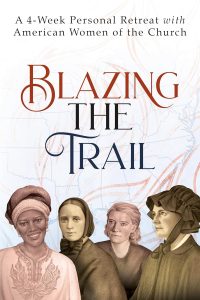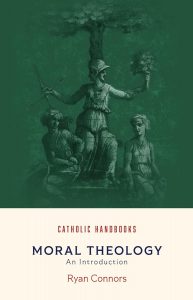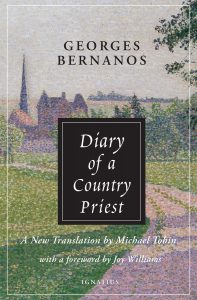Jérôme Lejeune: A Man of Science and Conscience. By Aude Dugast. Reviewed by Fr. John J. Conley, SJ. (skip to review)
An American Little Flower: Blessed Miriam Teresa Demjanovich. By GinaMarie Tennant. Reviewed by Aaron Martin. (skip to review)
Blazing the Trail: A 4-Week Personal Retreat with American Women of the Church. By Vinita Hampton Wright. Reviewed by S.E. Greydanus. (skip to review)
Moral Theology: An Introduction. By Fr. Ryan Connors. Reviewed by Fr. Joseph Ferme. (skip to review)
Diary of a Country Priest. By Georges Bernanos, trans. Michael Tobin. Reviewed by Clara Sarrocco. (skip to review)
Jérôme Lejeune: A Man of Science and Conscience – Aude Dugast
Dugast, Aude, Jérôme Lejeune: A Man of Science and Conscience, trans. Michael J. Miller. San Francisco: Ignatius Press, 2021. 393 pages.
Reviewed by Fr. John J. Conley, SJ.
 Some biographies explain; some biographies inspire. Aude Dugast’s biography of Jérôme Lejeune (1926–1994) manages to do both. Carefully researched, including interviews with members of Lejeune’s family, Dugast’s biography details the life of a preeminent French physician and scientist who achieved international acclaim when he discovered the chromosomal cause of Down syndrome and who encountered professional opprobrium when he denounced abortion from a scientific perspective.
Some biographies explain; some biographies inspire. Aude Dugast’s biography of Jérôme Lejeune (1926–1994) manages to do both. Carefully researched, including interviews with members of Lejeune’s family, Dugast’s biography details the life of a preeminent French physician and scientist who achieved international acclaim when he discovered the chromosomal cause of Down syndrome and who encountered professional opprobrium when he denounced abortion from a scientific perspective.
During the 1950s Lejeune began to focus his research on genetics. His interest fastened on the enigma of Down syndrome. People with Down syndrome usually showed certain types of mental disability and certain physical characteristics in the face and the eyes. In the 1950s people with Down syndrome were often called “Mongoloids” since their facial characteristics struck Caucasian onlookers as vaguely Asian. The moniker also supported prejudice and exclusion against people with Down syndrome, since the “Mongolian” condition was considered a mysterious type of throwback to an earlier, less intellectual type of humanity. By 1958 Lejeune had concluded that the cause of Down syndrome was actually an additional chromosome in the genetic constitution of the person with the condition.
Lejeune’s scientific breakthrough brought him international recognition in the medical and political communities. He received countless awards, was inducted into prestigious learned academies, and was the featured speaker at international conferences. He was elected dean of the medical school at the University of Paris. But as the tumultuous 1960s came to end, Lejeune would enter a new phase of his life as an eloquent opponent of abortion and of the new eugenicist spirit of the medical profession. A speech in San Francisco would be the turning point.
In 1969 the American Genetics Society awarded Lejeune its greatest prize: the Allen Memorial Prize for genetic research. Long disturbed by the growing approval of abortion in the medical and scientific communities, Lejeune decided to use his speech at the award ceremony in San Francisco to remind his colleagues that the human embryos and human fetuses they studied in the course of their genetic research were human beings whose lives must be protected. His rhetoric was blunt: “To kill or not to kill, that is the question. For millennia, medicine has striven to fight for life and health and against disease and death. Any reversal of the order of these terms of reference would entirely change medicine itself . . . Our duty has always been not to inflict the death sentence but to relieve the pain.” (144) Rather than applauding, the audience responded in stunned silence.
In following years, Lejeune intensified his pro-life advocacy. He campaigned against the Veil Law, which legalized abortion in France in 1975. He testified before Congressional committees in the United States. A close ally of John Paul II, he served as a spokesman for the Holy See at international conferences on demography and human rights. His status as a prestigious scientist and expert on genetics made him a particular target of the culture of death. Pro-abortion advocates disrupted his speeches and even launched projectiles at him. Even in death, he continued to provoke. In 1997, when John Paul II made a detour from the World Youth Day in Paris to pray at Lejeune’s tomb in a rural village, the French press excoriated this tribute to “an enemy of choice.”
Dugast’s biography is part hagiography. She details the influence of Lejeune’s lifelong Catholic faith on his behavior, especially in the difficult years when the pro-abortion establishment turned against him. The virtues of patience, forbearance, and charity were never lacking as he faced his accusers. The relationship with the Church was not an easy one. He lamented and protested the surrender of parts of French Catholicism to the culture of death, such as the Catholic University of Lille’s practice of in vitro fertilization. He often admonished his Catholic pro-life allies to avoid using theological arguments in the political debate over abortion, since such arguments reinforced the claim of pro-abortion activists that anti-abortion efforts were simply a case of Catholics trying to “impose their morality on others.”
At his death, thousands of colleagues and friends asked the Vatican to open Lejeune’s case for canonization. In 2021, Pope Francis declared him “Venerable,” citing his heroic virtues.
Rev. John J. Conley, S.J. holds the Knott Chair in Philosophy and Theology at Loyola University Maryland.
An American Little Flower – GinaMarie Tennant
Tennant, GinaMarie. An American Little Flower: Blessed Mirian Teresa Demjanovich. San Francisco: Ignatius, 2023. 208 pages.
Reviewed by Aaron Martin.
 The first time that I read St. Thérèse of Lisieux’s autobiography, Story of a Soul, I was repulsed. The book had been assigned in an Introduction to Spirituality course and it was, to my 18-year old, know-it-all mind, a sappy, saccharine story of a childish girl who was not intellectually gifted enough to strive for anything except her “Little Way.” I assumed that because her approach to holiness was diminutive, so too was her outlook. I assumed that because she did not do demonstrably great — and outwardly visible — feats, her spirituality was somehow less because it was so interior.
The first time that I read St. Thérèse of Lisieux’s autobiography, Story of a Soul, I was repulsed. The book had been assigned in an Introduction to Spirituality course and it was, to my 18-year old, know-it-all mind, a sappy, saccharine story of a childish girl who was not intellectually gifted enough to strive for anything except her “Little Way.” I assumed that because her approach to holiness was diminutive, so too was her outlook. I assumed that because she did not do demonstrably great — and outwardly visible — feats, her spirituality was somehow less because it was so interior.
It took my own health issues and a vocational crisis — my first experience of actual suffering — to reveal to me the genius of St. Thérèse. The Little Way was simple, but it certainly was not easy. It was small, but not pusillanimous. To the contrary, the Little Way led Thérèse — and could lead anyone — to a level of sanctity that was previously inconceivable. Each of us are called, little by little, to pursue sanctity in the everyday things of ordinary life.
Blessed Miriam Teresa Demjanovich (1901–1927) was humble enough and holy enough to realize St. Thérèse’s importance and impact early in her life. In fact, Miriam Teresa was nearly St. Thérèse’s contemporary, being born only four years after St. Thérèse died. Miriam Teresa read Story of a Soul when she was a girl. At the time, the book was brand new, coming out in the last few years of the nineteenth century. And it became a guiding light for Miriam Teresa. Miriam Teresa said she had been attracted to Carmelite spirituality “for a long time, ever since Charles gave me a biography of Saint Teresa of Avila. . . . [S]ince I was a child I have wanted to contemplate God and live for Him alone.” (96) Reading Story of a Soul, Miriam Teresa was inspired to continue living out a simple and deep faith.
Miriam Teresa’s story tracks St. Thérèse’s in many ways. Both were refused entry into Carmel at an early age. For Miriam Teresa, the rejection led to her attending college at a school run by the Sisters of Charity. That would become a formative time for Miriam Teresa. She developed a small community of friends who would make her undergraduate years enjoyable. Miriam Teresa had a very natural spirituality, and prayer came easy to her. She became a spiritual teacher to her classmates, though they did not know it at the time. A chaplain, Father Benedict, used to give spiritual conferences to the young women. What the women did not realize, however, was that Father Benedict had seen Miriam Teresa’s deep spirituality and asked her to write the conferences that he presented to the women. She did, and Father only told the women that Miriam Teresa was the author shortly after her death in 1927.
After college, a few of those friends entered the convent to be Sisters of Charity and Miriam Teresa was able to follow suit a few years later. Her entry, however, was marked with suffering not unlike what St. Thérèse experienced. Miriam Teresa was medically fragile and spent a significant amount of time in the hospital. In fact, she made her final vows in religious life while lying in a hospital bed. Two days after a surgery for a severe case of appendicitis, Miriam Teresa died at the young age of 26.
Like St. Thérèse, Miriam Teresa remained open to God’s will throughout her life and sought to follow it when and where it led her, through physical suffering and despite her fellow sisters not understanding her. Miriam Teresa wanted to sanctify herself and her community, and she took every opportunity to do so. Her life was an early example of the Little Way in practice, and her life and example have borne fruit ever since. She was beatified in 2014.
If there is a criticism of the book, it is that it often reads more like historical fiction than a biographical account. There are no citations throughout, so the reader is left wondering where the author came up with her material. Surely, the content of late-night conversations Miriam Teresa had with her classmates are made up, but they do seem consistent with what she would have said based on her written words. Given that her cause was opened in 1945, there would have been many people alive at the time who could have testified and recounted specific conversations.
The book is not a highly researched biography, but it does not purport to be one either. Rather, it is a solid late-middle-school-level introduction to this woman. And for anyone interested in native-born American saints, An American Little Flower will likely whet the appetite to find out more.
Aaron Martin, JD, PhL, and his wife live in Scottsdale, AZ with their four children. Aaron owns his own law practice and serves in various ways in the Diocese of Phoenix. He also is a member of the USCCB’s National Review Board. He writes at martinlawandmediation.substack.com. All opinions expressed here are his own.
Blazing the Trail – Vinita Hampton Wright
Wright, Vinita Hampton. Blazing the Trail: A 4-Week Personal Retreat with American Women of the Church. Notre Dame, IN: Ave Maria Press, 2025. 174 pages.
Reviewed by S.E. Greydanus.
 What is the particular value in focusing on saintly figures from among American women? In learning about the saints of their own nation or region, readers learn about their spiritual formation and heritage. As for holy women, particularly those described as “trailblazers,” the Church in any part of the world needs mothers as well as fathers. Vinita Hampton Wright profiles four holy women from American Catholic history, two canonized saints (Elizabeth Ann Seton and Frances Xavier Cabrini) and two Servants of God (Dorothy Day and Sister Thea Bowman). Wright’s new book is a sequel to her Set the World On Fire, a similar deep dive into the four female Doctors of the Church; but it is not necessary to have read that book before reading this one.
What is the particular value in focusing on saintly figures from among American women? In learning about the saints of their own nation or region, readers learn about their spiritual formation and heritage. As for holy women, particularly those described as “trailblazers,” the Church in any part of the world needs mothers as well as fathers. Vinita Hampton Wright profiles four holy women from American Catholic history, two canonized saints (Elizabeth Ann Seton and Frances Xavier Cabrini) and two Servants of God (Dorothy Day and Sister Thea Bowman). Wright’s new book is a sequel to her Set the World On Fire, a similar deep dive into the four female Doctors of the Church; but it is not necessary to have read that book before reading this one.
Wright is in earnest in calling her work a “retreat.” Blazing the Trail is not simply a series of readings for reflection, but an organized program of prayers, meditations, and activities. As the subtitle indicates, the retreat is divided into four weeks, with a week spent on each of the women. Each day of the week has a theme or topic: Saturday and Sunday are introductory; the following weekdays, Monday to Friday, take themes like “Conversion,” “Prayer and Faith,” “Integrity,” etc. Each of these themed weekdays is further divided into “Morning Prayer” and “Evening Prayer,” with a structured set of brief subsections: prayers, excerpts from Scripture and from the saints’ writings, glosses, points for reflection, and suggested activities to make the points of meditation concrete.
Thus, the book is not designed for those simply looking for devout reading material, or for readers who like to “lose themselves” in a text. It is not a substitute for saints’ biographies, though it could be a fine supplement. It will be most helpful to someone looking for an aid or guide to daily devotions, especially for those who like to pray with brief excerpts of reading or suggested prayers. It could be well suited to group prayer.
Blazing the Trail enters deeply into the story and message of each holy woman, remarkably so given its slim page count, with a refreshing simplicity and directness. Its greatest gift is the extended quotations in which the women speak for themselves, enabling readers to come to know them directly. (Thus, as Wright notes regretfully in the introductory pages, St. Kateri Tekakwitha could not have been included, as she wrote nothing and few quotes from her have been preserved.) In addition, the first day of each week encourages readers to learn more elsewhere about the subject of that week.
This matter-of-fact presentation, with its emphasis on message and mission, may be welcome and easily received during the sections on Sts. Elizabeth Ann Seton and Frances Xavier Cabrini, both of whom were controversial in their day but are generally no longer so. For some readers, this approach may become more difficult in the week dedicated to Servant of God Dorothy Day (1897–1980), whose crusade of serving the poor and battling social injustice remains as provocative today as it was in her lifetime. Wright faithfully articulates Day’s forceful spirit; for instance, the introduction to the chapter on “Justice” states, “Love for others naturally involved speaking out for justice; the two could not be separated” (103). Whether or not one agrees with all of the Servant of God’s opinions or personal choices, her dramatic example illustrates what can happen when one person takes the Gospel deeply to heart, and what might happen if more people did the same.
A challenge of a different kind emerges in the section on Sister Thea Bowman (1937–1990), who, as Wright observes, “was born in the right place and at the right time” (123) to make a unique contribution to, simultaneously, the Civil Rights movement and the history of the American Church. Some of the chapter topics in this section are certainly unusual for a retreat: “Heritage and Beginnings”; “Song and Dance”; “One Christ, Many Cultures.” Within the context of reflections on Sister Thea, whose apostolate is inseparable from her Black identity, such topic choices may be ways of considering why these subjects matter in Catholic life. To recognize the importance of her culture and background is essential in any discussion of her story—a story that deserves to be more widely known.
The power of her message, on the other hand, could have been more effectively presented if more exploration of Sister Thea’s personal sanctity had also been included. In the often-quoted words of Pope St. Paul VI, “Modern man listens more willingly to witnesses than to teachers, and if he does listen to teachers, it is because they are witnesses.” (Evangelii Nuntiandi §41) Sister Thea was nothing if not an effective witness; it was in coming to know her that hearts were changed around her.
Then, too, a handful of the questions and prompts for meditation read not too differently from secular motivational thoughts (recognizing one’s gifts, being at home in oneself, etc.); all good, wholesome ideas, but not necessarily the type of specifically spiritual reflection for which one comes to a retreat. Most, however, keep their focus on some aspect of spiritual growth. All in all, Blazing the Trail is an accessible, detailed, and thoughtful guide to four extraordinary holy women of the United States, one that will be read fruitfully by those looking to supplement their prayer lives or become better acquainted with saints.
S.E. Greydanus is a freelance writer/editor, a lay Dominican, and managing editor of Homiletic & Pastoral Review.
Moral Theology: An Introduction – Fr. Ryan Connors
Connors, Ryan. Moral Theology: An Introduction. Cape Girardeau, MO: ECT Press, 2025. 136 pages.
Reviewed by Fr. Joseph Ferme.
 As a canon lawyer, I spend an above-average amount of time thinking about law. And in a world obsessed with freedom, law is, perhaps surprisingly, the answer. Far from the world’s current and misguided notion of law as something merely restrictive, the Church’s wisdom informs us that true law leads to freedom, especially the New Law of the Holy Spirit. Thus, the study of moral theology — the moral law — can be described as the study of true freedom. As Fr. Connors aptly puts it, “moral laws are not arbitrary impositions or restrictions on man’s freedom but rather necessary and salutary pathways to his flourishing” (58). Moral Theology: An Introduction, then, is a true guidebook to freedom.
As a canon lawyer, I spend an above-average amount of time thinking about law. And in a world obsessed with freedom, law is, perhaps surprisingly, the answer. Far from the world’s current and misguided notion of law as something merely restrictive, the Church’s wisdom informs us that true law leads to freedom, especially the New Law of the Holy Spirit. Thus, the study of moral theology — the moral law — can be described as the study of true freedom. As Fr. Connors aptly puts it, “moral laws are not arbitrary impositions or restrictions on man’s freedom but rather necessary and salutary pathways to his flourishing” (58). Moral Theology: An Introduction, then, is a true guidebook to freedom.
This short volume is the second installment in the new Catholic Handbook Series published by the Encyclopedia of Catholic Theology, a most timely project in an era marked by an overall crisis of catechesis. Fr. Connors’ contribution to this important series can serve to address a more particular crisis: the question of man, for “moral theologians seek to discover the full truth about man” (xxiii) — a truth desperately in need of recovery today.
This volume is certainly an introduction, in the true sense of the word. Fr. Connors demonstrates a wise pedagogy of leading his reader into the subject matter, evidence of an experienced teacher. The text with endnotes is less than 135 pages, making it utterly accessible. At the same time, it is a holistic treatment of moral theology, offering a true survey of the subject. This volume is a real achievement in offering us an eminently readable presentation of the essentials of moral theology without venturing off into superfluous detail. It is neither cumbersome, nor lacking in essentials. Whether the reader has taken many moral theology courses, or this is his or her first venture into the topic, Fr. Connors’ book is a worthy read. Prudence requires “hearing from those possessed of some wisdom in the matter” (89), and Fr. Connors has certainly proved himself — here and in his other works — as wise in the matter at hand.
After an introduction exploring the nature of moral theology and a brief overview of its history, Fr. Connors expands upon the doctrinal foundations of moral theology: beatitude, especially Aquinas’ understanding of it, and the imago Dei. Such a foundation is required, for “contemporary debates about moral matters most often are grounded in disputed conceptions about human nature more than in disagreements about specific moral prescriptions” (19).
After this doctrinal foundation, the finer points of moral theology are dealt with, namely the moral object and the sources of morality. A firm grasp of these points greatly aids the confessor in helping his people to make sense of their own actions and in guiding them to perfective acts. Fr.Connors presents what can sometimes be a thorny subject with simplicity and clarity. The influence of Servais Pinckaers is then made explicit with a chapter on freedom for excellence. Fr. Connors shows how there can be no true concept of freedom separated from a consideration of the objective truth of reality and the good of persons.
The book continues with the topics of virtue, sin, the moral law, grace and merit, following the wise ordering established by Aquinas in the Summa. These topics are each presented with an impressive combination of thoroughness and conciseness. The next chapter shows Fr. Connors’ desire to think with the Church as he outlines the importance of magisterial teaching on moral issues. Finally, the introduction concludes with three chapters providing an overview of the ensemble of virtues and gifts which come with grace, and by which the vision of God is attained. Just these final three chapters alone would make this volume worthwhile. It serves as a short but precise description of these various habitus by which we live out the Christian life: the theological virtues, the moral (or cardinal) virtues, and the gifts of the Holy Spirit. Moral Theology: An Introduction will serve priests who are tasked with forming consciences and assisting people to live in accord with the wisdom of God, and who are called to be moral examples themselves. It can be seen as a true guidebook for confessors and preachers, for it falls to us “to assist Christian believers to recognize that their lives as followers of Christ involve much more than the mere avoidance of mortal sin” (77).
As is pointed out in the very first pages of the book, moral theology is not about “right and wrong,” but about the graced actions of man which direct Him to beatitude. Unfortunately, many people today — both in and out of the Church — view the life of discipleship as nothing other than a system of rules and regulations. They miss the lofty goal and promise of the Christian life which is true transformation in Christ, a true sharing in God’s life. For those of us tasked with forming the consciences of our people and directing them towards this goal, Fr. Connors offers us in this compact book an excellent resource to assist us in that godly work.
Rev. Joseph Ferme, JCL, is an adjunct professor of canon law at St. John’s Seminary in Boston.
Diary of a Country Priest – Georges Bernanos
Bernanos, Georges. Diary of a Country Priest. Translated by Michael R. Tobin. Ignatius Press, San Francisco. 2025. 299 pp.
Reviewed by Clara Sarrocco.
 In February 1932, C.S. Lewis wrote in a letter to his friend Arthur Greeves: “I can’t imagine a man really enjoying a book and reading it only once.”
In February 1932, C.S. Lewis wrote in a letter to his friend Arthur Greeves: “I can’t imagine a man really enjoying a book and reading it only once.”
Georges Bernanos wrote Diary of a Country Priest in 1936. In the interim years, if you have only read it once, heed Lewis’s advice and read it again, only this time read the newly translated version. Ignatius Press has published a new and more complete translation by Canadian scholar and Bernanos expert Michael R. Tobin. This translation not only restores some omitted passages in the 1936 edition but also updates the language.
Diary of a Country Priest was awarded the Grand Prix for Literature by the Académie française in 1936 and was made into a successful film by French director Robert Bresson in 1951. USA Today called it “the best spiritual book of the 20th century.”
It is the story of a young pastor in rural France. The book takes the form of a journal or diary and becomes the “stream of consciousness” so completely that one begins to believe it is a real diary and not just a novel. That is probably one of the greatest accomplishments which a novelist can achieve.
The story begins with the young priest beginning his parish work in the village of Ambricourt in Northern France. The village is fraught with skepticism, mistrust, gossip, and religious hypocrisy. His own feelings of inadequacy, his spiritual doubts, God’s silence, and his physical sufferings form his inner and outer struggles. His youthful idealism is misunderstood by his flock and his physical health deteriorates. He must cope with not only a lack of appreciation but also with the outright rejection by the parishioners. It seems to him that every effort he makes is accompanied by failure. The curé is truly a suffering soul both in his heart and in his body. As his health deteriorates and his “dark night of the soul” continues, he subsists mostly on bread and wine both literally and figuratively.
His one moment of happiness and freedom occurs when he accepts a ride from a friend on a motorcycle. The wild ride takes him through the French countryside with the wind blowing in his face. He is almost jubilant, not realizing that the trip is bringing him closer to his fate. He is on the way to catch a train to Lille to visit a doctor about his deteriorating health. It is in the doctor’s office that he receives his death sentence — cancer of the stomach. The climax of the story occurs with the climax of his life. From the doctor’s office, he finds his way to the apartment of a friend — a former priest who is living a questionable life. It is here that he dies receiving the blessing of the renegade priest. His last words are his redemption: “What difference does it make? All is grace.” Bernanos ends with “I think he died just then.”
“I can’t imagine a man really enjoying a book and reading it just once.” – C.S. Lewis
Clara Sarrocco is the longtime secretary of The New York C.S. Lewis Society. Her doctoral dissertation was on C.S. Lewis and von Hildebrand.

Speak Your Mind